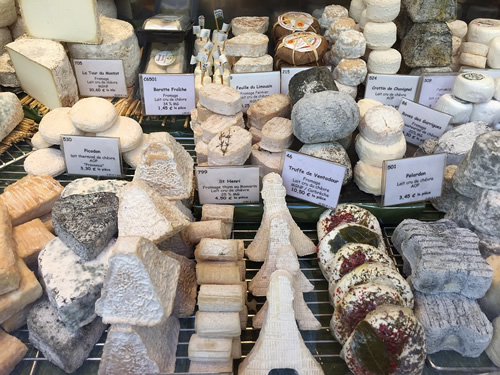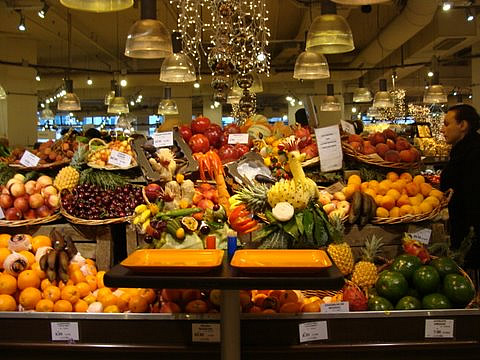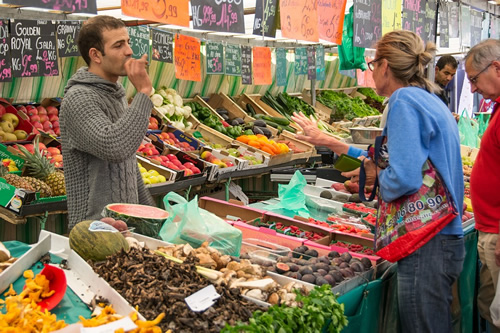12 Guidelines for Eating Well in Paris
Culinary Deals and Delights in the Capital of France
By Phyllis Cohen

|
|
In Paris, there are many fine small restaurants and bistros where you can enjoy food without spending a fortune.
|
1. Choose a good food guidebook. Although Michelin has long been
the "official" food book for the French looking up good restaurants in Paris and has very stringent standards and methods to scope out and evaluate the best of the best, for my money you're better served with the Time
Out Paris or the Zagat
Guide to Paris. Both give you the skinny on what real people like or don't like. If you have time for a longer read, get Patricia Wells' Food
Lover's Guide to Paris, which in my opinion is absolutely reliable.
2. Study your online or print map of Paris
. Guidebooks will tell you which area, or arrondissement, you are looking for. If all you have is a postal code, look at the last two digits. For example,
75004 is the 4th arrondissement.
3. Save money for a good meal
. Drink your coffee standing at the bar (sitting down doubles the price). If you only want a quick refresher, stop in a small grocery store
and pick up a bottle of water for 1-2 euros. If your hotel doesn't include breakfast in the rate, strike out on your own. Most cafes will have a breakfast special of coffee, fresh-squeezed orange juice, and croissant for 8-10 euros — much less than a hotel
breakfast.
4. Check for lunch specials. While an evening meal at 2-3-star restaurants can easily run $500-$1,000 for two, many have special menus at lunch time-more like $200 for two. If your heart is set on a meal of a lifetime, it is advisable to call
one or two months ahead of time and book a table.
5. Avoid highly touristed areas. If the menu outside is in five languages, chances are it's not a culinary jewel and is likely serving food than you could eat at a restaurant at home, which is a shame when you are in a culinary capital.
6. Go for the prix-fixe menu.
Most restaurants will have a fixed menu giving several choices for the appetizer, main course, and dessert. These are almost always cheaper than ordering à la
carte.
7. Think picnic or bring the food to your vacation rental
. All of the grocery stores in Paris have a wine section, and you can always find a decent Bordeaux for 10-20 euros. A trip to a fromagerie, or cheese store, is in itself
a sensual delight. Unlike America's over-processed cheese, the 1,000 French cheeses are living things. Ask for a cheese that is ready to be eaten today (pour aujourd'hui, s'il vous plaît); if you like pungent cheeses, ask for fort; if you like sweet,
mild cheeses, ask for doux. Stop off at the local boulangerie (bakery) for a baguette and you have a meal fit for a king. For dessert, stop into a chocolate shop or a patisserie (pastry shop).
If you happen to stay in a hotel with a fridge or do a vacation rental via airbnb or some other service, you can bring home food and eat like royalty. You can even cook in a vacation rental with all the great fresh ingredients if you are so inspired.

|
|
A fromagerie in Paris will typically offer up so many delicious cheeses it is hard to know when to stop sampling for your personal picnic.
|
8. For a fancy picnic, try a traiteur.
There's no exact translation for a traiteur; it's best described as a purveyor of fine foods that are ready to eat. Here you will find such
dishes as jellied eggs and salmon, fish mousse, and stuffed eggplant. If you are uncertain exactly where to find a traiteur, try one of the five largest in Paris: Fauchon, Galeries Lafayette, and Bon
Marche. Galeries Lafayette has a very large food court with everything from paté to caviar to Mediterranean food. And Bon Marché, on the Left
Bank, has a food store beyond compare. Imagine the most extensive gourmet food store you've ever seen and then quadruple it.

|
|
Just some of the offerings at the nearby Bon Marche in Paris.
|
9. Explore the neighborhood outdoor food markets. These movable farmers' markets bring the freshest fruits, vegetables, olives, cheese, poultry, etc. A few — like the one on the rue du Buci in the Latin Quarter — are open daily. A particularly fascinating one is on Sunday mornings under the Metro overpass on line 6 between Dupleix and La Motte Picquet-Grenelle in the 15th.

|
|
A vendor at one of the many markets in Paris offering up very fresh and tasty vegetables.
|
10. Check for the neighborhood spots. One bistro that serves our favorite duck with garlic sautéed potatoes to die for is located in Pigalle, of all places, right near the
leather boots, studs, and whips. Small gems are out there waiting to be discovered.
11. Look for regional restaurants. France has many regions, each with its own specialty. Chez Jenny by the Place de la République has many different types of choucroute.
Léon de Bruxelles specializes in mussels. Thomieux has cassoulet that will knock your diet back three weeks, and it's worth every bite.
12. Don't limit yourself to French food. Two of the finest Italian restaurants we've found anywhere are in Paris: Chez Vincent in the 19th and da Mimmo's in the 10th. Both have phenomenal
antipasto buffets. As you wander through the Marais in the 4th, you smell old world pastrami and falafel. Paris is an incredibly international city, with many great Vietnamese to Moroccan restaurants.
These tips will help you avoid wasting a precious meal in Paris on a mediocre restaurant. What I can't help you with is the dilemma of choosing between returning to a restaurant you love or trying something new. Bon
appétit!
|
